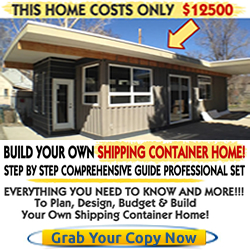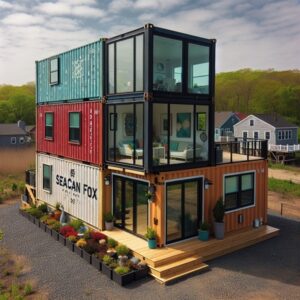
My Favorite Container Homes Resource
I compared the top 3 Container Home Guides
to discover the ultimate resource!
See my top recommendation here
Key Takeaways
- Explore various finance options for shipping container homes, including traditional mortgages, personal loans, and specialized loans.
- Understand the steps to secure financing, such as improving your credit score and finding the right lender.
- Discover grants and assistance programs that can help fund your shipping container home project.
- Consider the cost implications of DIY construction versus hiring a professional builder.
Breaking Down Shipping Container Home Finance Options
When it comes to building your dream home from shipping containers, the financial aspect can seem like uncharted territory. But fear not, because with the right guidance, financing your container home can be as straightforward as any traditional house purchase. Let’s delve into the finance options that can transform your blueprint into a real home.
Understanding Your Lending Choices
First things first, you need to know what’s available to you. There are primarily three types of finance options for container homes:
- Traditional Mortgages: Yes, banks do finance shipping container homes. However, they often see them as modular or manufactured homes, which can affect the loan terms.
- Personal Loans: These can be more flexible than mortgages and are a good fit if you’re looking at a lower borrowing amount.
- Specialized Container Home Loans: Some lenders are now offering loans tailored for the unique needs of container home builders.
Most importantly, each of these options comes with its own set of terms, rates, and requirements. So, it’s crucial to shop around and find the one that aligns with your financial situation and goals.
Steps to Secure Your Financing
Now, let’s map out the path to securing that loan. Here are the steps you should follow:
- Check Your Credit Score: This number will largely determine your loan terms. Aim for a score that’s above average to secure the best rates.
- Prepare Your Documents: Gather all necessary paperwork, including proof of income, tax returns, and a detailed plan for your container home.
- Research Lenders: Look for banks, credit unions, and online lenders with favorable rates and experience in financing container homes.
- Compare Offers: Don’t just jump at the first approval. Evaluate terms and interest rates to ensure you’re getting the best deal.
- Get Pre-Approved: This will give you a clear idea of your budget and show sellers and contractors that you’re a serious buyer.
Because securing financing is a crucial step in the journey, take your time to understand each option and choose wisely.

Challenges and Solutions in Container Home Financing
Let’s tackle some potential challenges head-on:
Because shipping container homes are still a relatively new concept, some lenders may hesitate to offer financing. It’s essential to present a detailed plan that demonstrates the viability and value of your project.
Also, insurance can be more complex for container homes. You’ll want to find an insurer that understands and covers these unique dwellings.
Specialized Container Home Financing
When we talk about specialized container home financing, we’re looking at options crafted specifically for the needs of container home builders. These lenders understand the nuances and potential of container homes, offering loans that fit the unique mold of this innovative housing solution.
For instance, some lenders might provide construction-to-permanent loans that cover both the building phase and convert into a standard mortgage once your home is complete. This can streamline the process, allowing you to focus on the build rather than juggling multiple loans.
Building Grants and Assistance Programs
Believe it or not, there are grants and programs out there designed to help individuals build their own homes. These can be a godsend for your container home project, especially if you’re looking to minimize debt.
HOME Investment Partnerships Program
The HOME Investment Partnerships Program, for example, is a federal grant program aimed at creating affordable housing. Eligibility and availability can vary, so you’ll want to check with your local community development office to see if your container home project could benefit from this program.
Self-Help Homeownership Opportunity Program
Another program, the Self-Help Homeownership Opportunity Program (SHOP), supports homebuyers who are willing to put in “sweat equity” to construct their own homes. This is an excellent match for the container home community, where DIY is a big part of the ethos.
Finance Options for Building a Shipping Container Home
| Finance Type | Details | Source |
|---|---|---|
| Land and Construction Loan | Some lenders offer a loan that allows you to purchase the land and finance the construction of the home. Not all lenders offer these loans, and if the land isn’t permitted or cleared for a home, you will need to pay to get the property set up as well | 1 |
| Conventional Home Loan | You can use a conventional home loan to purchase a shipping container home. This may be an option if the home is an existing property. You can qualify for a conventional loan with a 3% down payment as a first-time homebuyer, 5% down as a repeat homebuyer, and a credit score of 620 | 1 |
| Federal Grant | The federal government offers a grant specifically for shipping container homes. The application process can be time-consuming and involves demonstrating how your project aligns with the government’s priorities | 2 |
| Container Home Financing | Container Home Financing offers mortgages for shipping container homes including construction loans and traditional mortgages | 3 |
Sources:
- Homeownership Hub – How To Get A Loan For A Shipping Container Home
- Container Convert – Federal Grant for Shipping Container Homes
- Container Home Financing

DIY or Hire a Builder: Cost Implications for Your Budget
One of the most significant decisions you’ll make is whether to take on the build yourself or hire a professional. This choice has a substantial impact on your budget and financing needs.
Understanding Construction Costs
However, if you’re handy and have the time, DIY construction can save you a considerable amount of money. You’ll still need to budget for materials, tools, and perhaps occasional professional help for the parts of the build that are beyond your expertise.
Maximizing Budget with DIY Strategies
For those considering the DIY route, here are a few strategies to stretch your dollars:
- Plan Thoroughly: A detailed plan can prevent costly mistakes and rework.
- Source Materials Wisely: Look for discounted or repurposed materials without compromising on quality.
- Learn Skills: Utilize online tutorials, workshops, and community courses to build the skills you need.
Remember, even if you’re going DIY, some aspects of the build, like electrical and plumbing, may require licensed professionals due to local codes and safety standards.

FAQ about Container Home Financing
Now, let’s address some of the most common questions regarding the financing of shipping container homes. These answers will provide clarity and help you navigate the financial landscape of
Do Banks Finance Shipping Container Homes?
Many banks and financial institutions are open to financing shipping container homes, treating them similarly to modular or manufactured homes. It’s crucial to present your project confidently and professionally to secure financing.
What Credit Score is Needed for a Container Home Loan?
A credit score of 620 or higher is generally a good benchmark for container home loans, although this can vary by lender. A higher score can lead to better interest rates and terms.
How Much Down Payment is Required for a Container Home?
Down payment requirements typically range from 5% to 20% of the home’s total cost, but some lenders may offer specialized programs with lower down payment options for container homes.
Can I Qualify for Grants to Build a Shipping Container Home?
Grants and programs are available to assist with
Are Container Homes Cheaper than Traditional Homes?
Container homes can be more cost-effective than traditional homes, often requiring fewer materials and a shorter construction timeline. However, the total cost can vary depending on the design, location, and finishing level.





